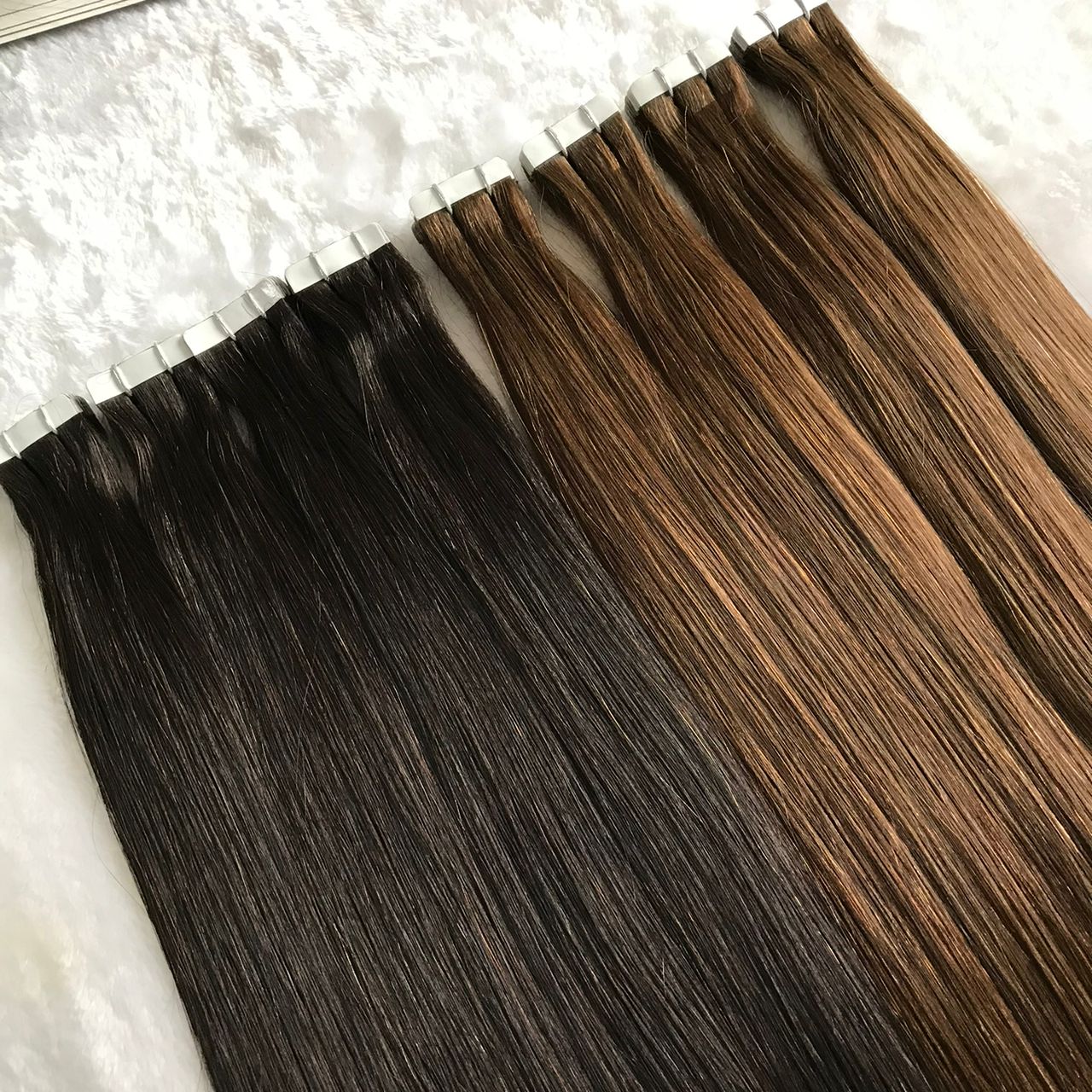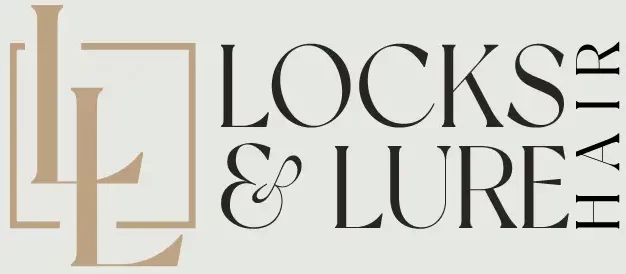
Tape-In Hair Extensions Buyer’s Checklist
✅ 100% Remy Human Hair: The best quality and means the cuticles are intact and aligned in the same direction which reduces tangling, matting, and gives you a more natural look and feel that can be styled and treated like your own hair.
✅ Consistency in Texture and Color: The hair should have a consistent texture and color throughout the wefts.
✅ Medical-Grade Adhesive: Look for descriptions mentioning high-quality, medical-grade, or hypoallergenic adhesive. This is crucial for a durable strong hold with no risk of slippage and that is safe for your scalp and natural hair upon removal. While strong, the adhesive should be designed to release effectively with a professional-grade removal solvent, minimizing damage during the re-application process. The tape tabs should be thin and flexible enough to lie flat against the head for a seamless, comfortable feel.
✅ Weft Construction & Secure Stitching: The hair should be securely attached to the tape tab to minimize shedding from the weft itself. Wefts should be dense to provide fullness but not so bulky that they are difficult to conceal. The best way to determine the right number of wefts (or grams of hair) is to consult with an experienced stylist. They will assess your natural hair’s thickness, desired length, and desired volume.
✅ Choose Based on Desired Look and Natural Hair: Select a length that will blend well with your natural hair while achieving your desired outcome (volume or length). Consider where the extensions will lay relative to your natural hair ends. Measuring from your ear down can help visualize lengths.
✅ Match Your Natural Hair: Choose a color that closely matches your natural hair color from the mid-lengths to the ends for the most seamless blend. Often, using a few different shades that are close to your natural color provides the most dimensional and natural-looking result.
Tape-in Hair Extensions Explained
Tape-in hair extensions are semi-permanent hair extensions where wefts (a bundle or collection of hair strands sewn or woven together along a thin, flexible band) are attached to sections of a person’s natural hair using a medical-grade adhesive tape. “Semi-permanent” in this case means the tape-in hair extensions, unlike temporary clip-in extensions that are removed daily, remain attached to your hair through washing, sleeping, and throughout your day. However, they are not truly permanent and require maintenance (removal and re-application) about every 6-8 weeks as your natural hair grows.
Applying tape-in hair extensions involves a kind of ‘sandwiching’ of a small amount of your natural hair between wefts of the tape-in hair extensions. Since tape-in extensions lie flat against your scalp, with proper application are seamless, comfortable and as previously noted, can last for up to a couple of months before needing maintenance.
Tape-in Hair Extensions Explained & Buying Guide: Washing
Maintaining tape-in hair extensions is simple and straightforward, to keep them looking great and protect your natural hair follow these guidelines:
When washing your tape-in hair extensions, use shampoos and conditioners that are specifically sulfate-free, alcohol-free, and oil-free, and here’s an explanation of why:
- Sulfates are detergents that can potentially break down the medical-grade adhesive used in the tapes over time. Repeated washings can weaken their bonding properties, making the hair extensions vulnerable to slipping or loosening.
- Certain alcohols can be moisturizing and others very drying. Drying alcohols can make the tape-in hair extensions brittle and thus less pliable, and or weaken the adhesive bond reducing its hold on your natural hair.
- Applying oil-based products too close to the tape bonds can degrade the medical grade tape’s adhesive properties and ability to grip the hair. When oil gets between medical grade tape and your hair, it acts like a lubricant, causing the tape to lose its grip and the extension to slip out.
Steering clear of sulfates, alcohols, and oils will help you preserve the strength of the adhesive bonds, ensuring your tape-in hair extensions are secured and remain in place while you go about your daily life.
Be gentle in washing and focus on your natural roots and allow the shampoo to run down the strands, avoiding active scrubbing or flipping your head upside down and whipping your hair around. The medical-grade tape is waterproof once bonded (48 hours after initial installation) and you don’t need to actively avoid water collection as part of the normal rinsing process.
Nonetheless it’s best to let water flow downwards and gently handle your wet. It’s also better to avoid washing practices that cause excessive water to pool and make your hair unusually heavy or difficult to manage while wet (flipping your head upside down as noted earlier). The weight of wet hair can be a lot, and while the tape adhesive bonds are strong, the increased weight combined with the hair being more prone to tangling when wet increases the risk of accidentally and unnecessarily stressing the tape bonds during the washing and rinsing. As for conditioning, apply conditioner mainly from the mid-lengths to the ends of the hair extensions, avoiding the roots where the tape is.
The primary concern regarding water is ensuring the bonds are completely and thoroughly dried after you get out of the shower. Hence when stepping out of the shower squeeze excess water from your hair with your hands, then blot it with a microfiber towel. Most stylists suggest washing your hair typically 2-3 times per week and using a dry shampoo in between washes if needed.
Tape-in Hair Extensions Explained & Buying Guide: Brushing & Styling
When it comes to brushing tape-in hair extensions it’s best to use a soft-bristle brush or a brush specifically designed for extensions. Avoid brushing when your hair is wet as this can cause tangling. Other than that simply take a gentle approach and hold your hair at the roots while brushing to avoid any excessive pulling on the tapes-in extensions.
You can usually style tape-in extensions just like your natural hair and that includes using heat tools like straighteners or curling irons. However be careful to avoid applying direct heat on the tape-in bonds themselves, as this can degrade the adhesive and be sure to use heat protectants designed to shield hair strands from the high temperatures of styling tools. Direct high heat applied to the tape bonds from straightening or curling irons, if held too close, can actually melt the adhesive “squishy” resulting in easy slippage.
Tape-in Hair Extensions Explained & Buying Guide: Installation
The installation time for tape-in hair extensions can vary depending on several factors, but generally speaking, a full head installed by a professional stylist can be done in anywhere from 30 minutes to 1.5 hours. Of course the more wefts, the more time and a partial installation for adding volume will take less time than a complex or full head for both length and volume. The thickness and length of your hair can affect the sectioning and placement process or time involved as well. As your natural hair grows, the tape-in extensions will move down with it. To maintain a seamless look and prevent tangling or tension on your roots, tape-in extensions need to be professionally removed and reapplied closer to the scalp typically every 6-8 weeks. The old tape is removed using a special solution, the extensions are cleaned and re-taped, and then re-applied.
Tape-in Hair Extensions Explained & Buying Guide: Outdoor Weather
Tape-in hair extensions can generally hold up well should you find yourself caught outdoors in the rain as the medical-grade adhesive used is designed to be waterproof once properly bonded. But and importantly, while the tape is waterproof, prolonged dampness at the roots where the bonds are located can potentially weaken the adhesive over time if not dried thoroughly. So if your tape-in extensions get wet from rain, blot dry them with a microfiber towel as soon as possible at the roots and bonds, then use a blow dryer on a cool or warm setting to ensure the adhesive area is completely dry. Our human hair extensions react just as your natural hair to moisture and humidity from rain by becoming frizzy or more prone to tangling.
Heat and humidity can be challenging for tape-in hair extensions, as it affects both the hair strands and the adhesive bonds. In high humidity, the hair extensions, particularly if they are made of human hair and as noted, can absorb moisture from the air and may become prone to frizz or lose their style, just like your natural hair.
Tape-in Hair Extensions Explained & Buying Guide: Hair Dye Application
Yes, our tape-in extensions are made from 100% human hair and can be dyed. In fact it’s not uncommon for customers and stylists to darken or adjust the tone of the extensions. However lightening tape-in hair extensions through bleaching is often not recommended, as the hair has likely undergone processing leaving it more vulnerable to the harsh chemical process of bleaching, making damage likely become damaged. Be mindful human hair extensions have already been subjected to various chemical treatments necessary to achieve the desired color, texture, and overall appearance of the extensions. Bleaching hair that has already been through these processes is essentially layering one harsh chemical treatment on top of others. Bleaching is an aggressive process that works by opening the hair’s cuticle and breaking down the pigment inside the hair shaft which inherently causes stress and damage to the hair. On hair extensions that have already been processed, the effects are amplified leading to a loss of moisture, making the hair feel dry, rough, and brittle. So while it might be technically possible to attempt to bleach tape-in hair extensions, it is strongly not recommended due to the high probability of causing irreversible damage.
It’s usually best to dye tape-in hair extensions before installation or, if already installed, carefully apply the dye avoiding the tape bonds themselves. (dye chemicals can weaken the adhesive). For best results and to avoid damaging the hair or the tapes, it is highly recommended to have them dyed by a professional stylist experienced with coloring extensions.

